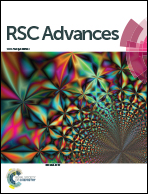Nanoparticle supported, magnetically separable manganese porphyrin as an efficient retrievable nanocatalyst in hydrocarbon oxidation reactions†
Abstract
A manganese porphyrin, meso-tetrakis(pentafluorophenyl)porphyrinato manganese(III) acetate, Mn(TPFPP)OAc, was immobilized on silica-coated magnetic Fe3O4 nanoparticles functionalized with 3-aminopropyltriethoxysilane (APTS) through the amino propyl linkage using a grafting process in toluene solvent. This enabled the covalent immobilization of Mn(III) porphyrin via an aromatic nucleophilic substitution reaction, to afford the Fe3O4@SiO2–NH2@MnPor catalyst. The resulting nanoparticles were characterized by X-ray powder diffraction (XRD), scanning electron microscopy (SEM), FT-IR spectroscopy, UV-Vis spectroscopy, elemental analysis (CHN), atomic absorption spectroscopy (AAS), and vibrating sample magnetometry (VSM). The immobilized manganese porphyrin was applied as an efficient and retrievable heterogeneous nanocatalyst in alkane hydroxylation and alkene epoxidation. Leaching and recycling experiments revealed that the prepared nanocatalyst can be recovered, and reused several times, without loss of activity and magnetic properties.


 Please wait while we load your content...
Please wait while we load your content...